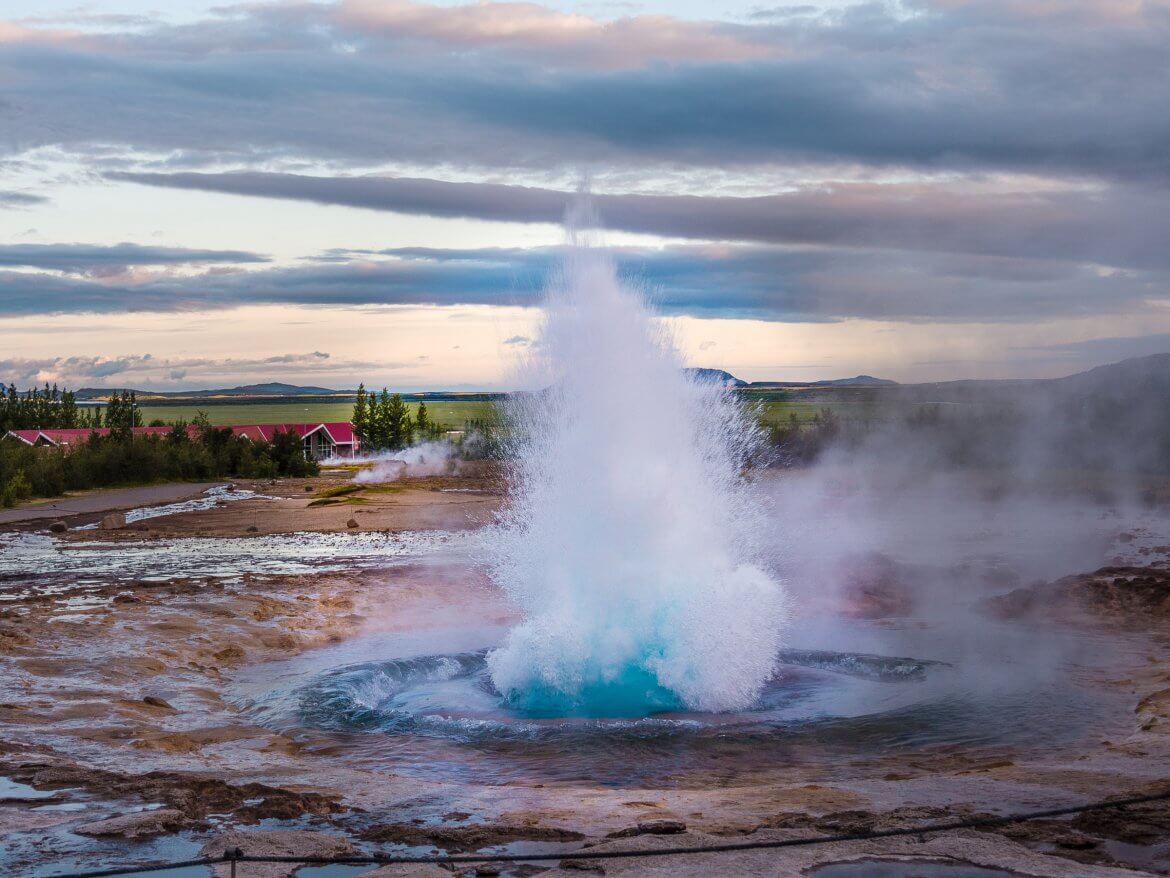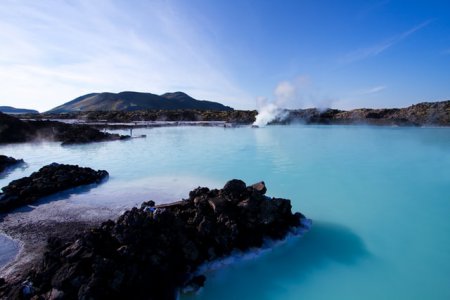The Nordic island state is known for its exceptional landscape. The island is surrounded by the Arctic Ocean and is a unique holiday destination thanks to the warm Gulf Stream and hot springs. Countless geysers, volcanoes, waterfalls and thermal springs are offered on the Icelandic island. Countless geysers, volcanoes, waterfalls and thermal springs are offered on the Icelandic island.
Reykjavik
The capital is worth a visit at any time of the year! It is located in the southwest of the island. It is the largest city on the Icelandic island, with almost 129,000 inhabitants. Reykjavik is situated on the widely curving Faxaflói Bay on the Atlantic Ocean, at the foot of the over 900-metre-high Esja mountain range. . 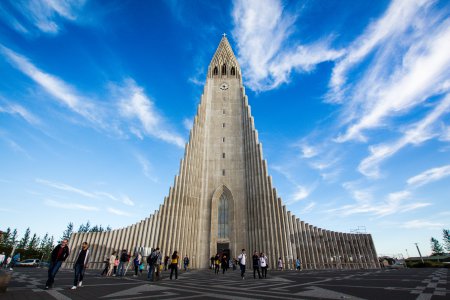
Due to its beautiful location, extraordinary buildings and vibrant life, the city is considered particularly worth living in and seeing. If you are drawn to Reykjavik, you can directly feel the unique charm of the world’s northernmost capital. You can experience a lot in a small space and let yourself be captivated by the Nordic flair. In addition to the extensive harbour and the idyllic Lake Tjörninin the middle of the city, Reykjavik also offers a large number of cultural institutions. Numerous museums, such as the National Museum (Þjóðminjasafn), the open-air museum Árbæjarsafn or the Photography Museum (Ljósmyndasafn) are definitely worth a visit.
Some of the city’s buildings have also established themselves as important sights and are a must-see during a stay in the capital. Among the oldest buildings in the city are the cathedral from the 18th century and the university “Háskóli Íslands“, which has existed since the early beginnings of the 20th century. One of the newer and more modern buildings in the city is the “Hallgrímskirkja“. With its striking architecture and height, the Lutheran church is considered a landmark of Reykjavik and offers a fantastic view over the city and the open bay to the impressive Esja mountain range.
Suppose you’re not here just for art and culture but want to get a closer look at the fancy fashion and Icelandic food. In that case, you’ll find opportunities for that too. In addition to long shopping streets and large shopping centres, cosy street cafés, restaurants, and bars invite you to enjoy authentic culinary delights. Although far removed from other European cities, Reykjavik is young and cosmopolitan and inspires with a real quality of life.
Iceland’s Northern Lights
Anyone dreaming of a trip to Iceland has one thing in mind besides the varied landscape with its volcanoes, glaciers and hot springs: the aurora borealis! On the island, these spectacular light phenomena, which are also known as “Aurora Borealis”, are best seen from September to April, with September and October, as well as February and March, being the most rewarding.
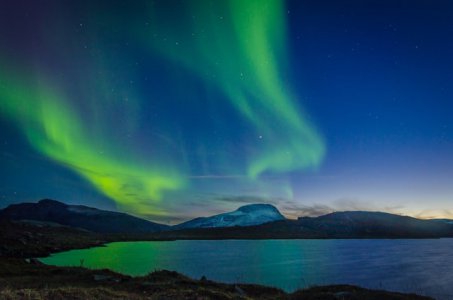
As Iceland lies just below the Arctic Circle, the Northern Lights can be easily seen from anywhere on the Icelandic island. The prerequisite for this is,
of course,that it is dark. Because of this, the period from May to August is not recommended, as it never gets completely dark in Iceland during these months. From September to April, you have much better chances. If you want to see the aurora borealis, it is best not to be in a city but out in the open. From around 20:00 in the evening to 04:00 in the morning, you are most likely to catch a glimpse of the indescribable lights.
If you’re on the hunt for the northern lights, you’ll know that winter is the best time to see them. During this time, it is darkest on the Icelandic island, and you can enjoy the picturesque, snow-covered landscape in addition to the magic of the lights.
Blue Lagoon
Fancy a little wellness holiday during your campervan trip? Southwest of the Icelandic capital lies one of the most famous thermal baths on the island: the extensive Blue Lagoon (“Bláa Lónið“) on the Reykjanes Peninsula.
Initially, the body of water was a simple “waste product” of the nearby Svartsengi geothermal power plant until the hot spring became increasingly popular and was eventually expanded. Today, the 5,000-square-metre outdoor thermal pool is a real tourist attraction and attracts a lot of Icelandic tourists. The lake is open to guests all year round. The water temperature averages 39°C degrees, making it inviting even in winter.
Over the years, the Blue Lagoon has changed, and small innovations have been made all around. For example, visitors can order their drinks at a bar in the water without leaving the warm water. Elsewhere, there is also a “mask bar” where you can buy various face masks or facial scrubs to make your spa day perfect. A restaurant caters for your physical well-being.
It is especially lovely to visit the “Blue Lagoon Iceland” in the twilight hours. Then the numerous jetties and the steaming water are illuminated and the thermal bath has its very own charm.
Jökulsárlón
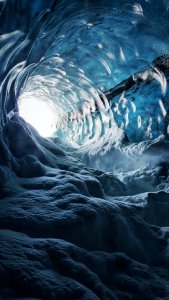
A good 400 kilometres from Blue Lagoon is an 18-square-kilometre glacial lake in the southeast of the country. It is located south of Europe’s largest glacier, Vatnajökull, between Skaftafell National Park and the small town of Höfn.. The body of water bears the beautiful name Jökulsárlón, which translates as “Glacier River Lagoon”.
Jökulsárlón is known for two things: firstly, it is the deepest lake in Iceland with a total depth of 284 metres, and secondly, it is known for the countless chunks of ice floating on it, which have very different sizes and unique shapes. These icebergs enter the huge lake through a glacier tongue of Vatnajökull, which in turn has a direct connection to the sea. The drift ice can grow up to an impressive 15 metres high. The countless chunks of ice on the lake shimmer bluish or even blackish, depending on the substance. The blue hue is caused by various crystals in the ice and their reflection, while the black comes from volcanic ash. Unique to behold!
Nature is capable of creating impressive settings. This is precisely the case with Jökulsárlón . Because of its unique beauty, the glacier lagoon has become a popular sight among travellers. There is a bridge over the river that connects the water with the open sea, and you can easily drive over it in your campervan. When you arrive at the car park, a small café offers delicious Icelandic delicacies. Next door, there is a counter offering day trips on various boats: The large amphibious boats guarantee a comfortable 40-minute trip across the vast glacial lake. Meanwhile, an English-speaking guide explains facts about the lagoon and the surrounding area. Those who like to travel a little faster and in a smaller group should book a tour on the Zodiac.
In addition to the spectacular icebergs, guests can also look forward to the varied wildlife of Jökulsárlón : In addition to lively seals, there are also plenty of birds to watch, such as Great Skuas and Arctic Terns. A black beach runs along the lake, called “Diamond Beach” because the ice on it resembles diamonds glittering in the sun.
If you are already familiar with the large glacial lake Jökulsárlón, you have probably seen “James Bond – Die Another Day or In the Face of Death”, “Tomb Raider” or “Batman Begins”. The lake has already served as a legendary setting for these and other film productions.
Askja and Víti
If you haven’t had enough of mighty volcanoes and glittering lakes, you should make a stop in the interior of the Icelandic island. North of Vatnajökull, in the middle of the national park of the same name, lies the majestic central volcano Askja with a height of 1,510 metres. This gigantic volcanic system in the middle of a lava desert consists of three cauldron-shaped surfaces, the so-called “calderas, ” which form the Dyngjufjöll mountain massif.
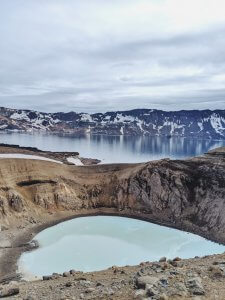
The Askja volcano has already had a long and eventful history of violent eruptions. The last major eruption in 1875 created two craters of different sizes, both of which are filled by a lake. The larger of the two is the lake “Öskjuvatn“, with an area of eleven square kilometres and an impressive depth of 220 metres. The smaller lake called “Víti“ has a diameter of a good 300 metres and lies right next to it.
Víti, the Hell Crater, as it is translated from Icelandic, is home to a lake whose water owes its muddy, milky colour to the high sulphur content. The water is a good eight metres deep and has a pleasant temperature of 23°C degrees on average. It is not only an exciting place but also an exceptional bathing spot. Because if you feel like going for a swim in an active volcanic crater, you can do it right here!
Skógafoss – Waterfall
Iceland is not only the land of glaciers and volcanoes but also has numerous waterfalls that you should definitely see. One of the largest and most elegant waterfalls is Skógafoss in the south of Iceland. It is located in a wide area between two green hilltops.
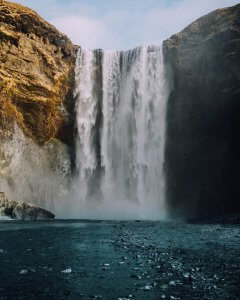
The waterfall is over 25 metres wide and plunges almost 60 metres. On a good day, you can admire not one but two beautiful rainbows!
The Skógafoss waterfall is located almost 150 kilometres southeast of Reykjavik. Once,the 60-metre-high edge of the waterfall formed the southern coastline of the Icelandic island. Today it no longer does; the sea is now almost five kilometres away. This is because, after the last great ice age, the entire island rose in such a way that a cliff at today’s height was formed at this point. The name Skógafoss translates as “forest waterfall” and goes back to a far-off time when this part of the Icelandic island was still covered with forest. Today, green hills line the landscape.
This Icelandic highlight has also been used as a backdrop in several film productions. For example, the Skógafoss waterfall can be seen in “Thor: The Dark World” and “The Amazing Life of Walter Mitty“.
Douglas DC-3 Sólheimasandur
Another must-see of the Icelandic island awaits you on an extensive, black sand beach along the south coast of Iceland: the Douglas DC-3 aircraft wreck on the shore of Sólheimasandur has established itself as one of Iceland’s most impressive and well-known sights.
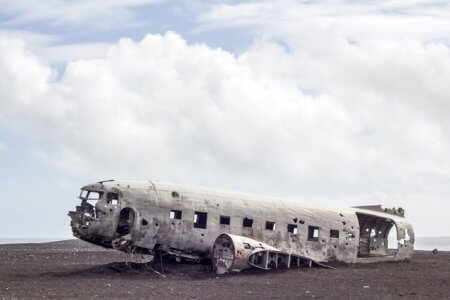 But how did the Douglas DC-3 end up on this Icelandic beach? On 21 November 1973, American soldiers were transporting supplies by air from Keflavík to Höfn. But on the way back, the weather deteriorated dramatically, and fierce winds caught the aircraft. At the same time, ice collected in the engines, whose service eventually failed. The pilots managed to make an emergency landing of the Douglas DC-3 on the pitch-black beach off the coast. The crew was rescued, but the wreckage was left behind. And so, decades later, it still lies on the lonely shore of Sólheimasandur.
But how did the Douglas DC-3 end up on this Icelandic beach? On 21 November 1973, American soldiers were transporting supplies by air from Keflavík to Höfn. But on the way back, the weather deteriorated dramatically, and fierce winds caught the aircraft. At the same time, ice collected in the engines, whose service eventually failed. The pilots managed to make an emergency landing of the Douglas DC-3 on the pitch-black beach off the coast. The crew was rescued, but the wreckage was left behind. And so, decades later, it still lies on the lonely shore of Sólheimasandur.
The sight seems like something from another world: The plane wreck is surrounded by deep black volcanic sand, far and wide, there is not a soul alive. Under these circumstances, the wreck of Sólheimasandur offers an extraordinary photo motif that you don’t see every day.
Like the Jökulsárlón glacier lagoon and the Skógafoss waterfall, this sight also became a backdrop that made history: the music video for Justin Bieber’s song “I’ll show you“ was filmed at this wreck, among others.
The Great Geyser and Geyser Strokkur
Most travellers associate the Nordic island state with hot springs and geysers. And rightly so! Who wouldn’t want to see colossal water fountains shooting metres into the air? The sight of these geysers is a unique natural phenomenon and well worth the wait.
There are two major geysers in Iceland: the Great Geyser, which gives its name to all the other hot springs and is probably the most famous geyser in the world. The other is the Strokkur Geyser, which is considered the most active geyser in Iceland. Both are located in the hot water valley Haukadalur in the southwest of the Icelandic island and are only a few hundred metres apart.
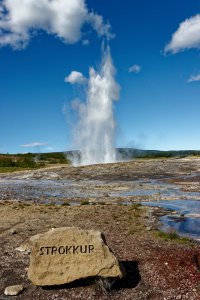
The Great Geyser was first mentioned in the 13th century and is still considered the oldest geyser in the world. It has been active for centuries. However, while in 1845 it spewed out columns of water up to 170 metres high, a year later, the fountains only managed to reach a height of about 50 metres. After that, it was considered inactive for a long time until it was finally reawakened by an earthquake in 1896. Towards the end of the 19th century, it erupted several times a day and reached heights of up to 60 metres. Then there were years of inactivity and years of occasional, more minor eruptions until it became active again in the summer of 2000 after a long period of inactivity. Since then, it has been ejecting occasional fountains of water. Today, the hot water columns still reach up to ten metres. Even though the Great Geyser no longer shoots such huge water fountains into the air as it used to, the sight of these “smaller” fountains is breathtaking and an absolute highlight on Iceland.
The geyser Strokkur, which translates as “butter churn”, was first mentioned at the end of the 18th century, although it is assumed that both hot springs are roughly the same age. However, since the Great Geyser erupted earlier and much higher, its little brother was not mentioned until then. Since 1963, Strokkur has had regular eruptions, which occur about every five to ten minutes, and its hot water fountains reach a height of 20 to 30 metres.
To conclude
The Nordic island nation of Iceland is a longing destination for many people. Located in the middle of the Atlantic Ocean, it seems endlessly far away but can be reached within a few hours by plane or ferry. The best way to explore the Icelandic island is on your own: A campervan is the best way to do this, as it gives you the freedom and flexibility to go wherever you want. In addition to the lively capital with its abstract buildings and diverse museums, the island is primarily known for its unspoiled nature with hot springs, volcanoes and geysers. You’ll find plenty of sights and highlights all over the Icelandic island that you shouldn’t miss.
More information about Iceland and the situation of Covid can be found here.
